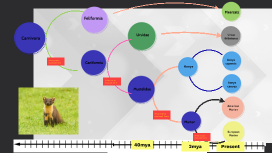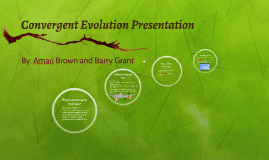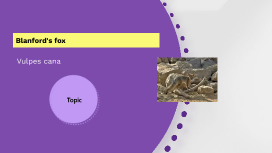Evolution Project: Taking Flight Template
Transcript: Switek, Brian. "New Candidate for World's First Bird." National Geographic. National Geographic Society, 30 May 2013. Web. 13 Feb. 2015. Filamentous Feathers Eight specimens ~150 million years ago Bavaria, Germany Thin Walled Bones Bipedalism was one of the first adaptations that would allow for flight Theropods Birds Advantages and Disadvantages of Bipedalism 'The First Biped' Long Second Digit http://evolution.berkeley.edu/evolibrary/article/0_0_0/evograms_06 "Dinosaurs: Two Legs or Four?" The Guardian. The Guardian, 07 Feb. 2007. Web. 11 Feb. 2015. Archaeopteryx Throughout the era of dinosaurs species evolved or lost the bipedal stance Dinosaurs The saurischian or "lizard hipped" dinosaurs are characterized by hips composed of three elements, long and flexible necks, and grasping hands with a long second digit. The saurichians fall into two major groups. The saurapoda were large herbivores while the theropoda were bipedal carnivores. Birds are descendents of the theropoda. Why longer arms? 90-million-year-old fossil Located in central Germany A 'bolosaur' names Eudibamus cursoris Hypothesized to have evolved a bipedal stance to escape from predators (speed) Majority of the original dinosaur species were bipedal There are two main hypothesizes as to how the evolution of feathers came about. 1) To escape predators... - Feathered arms allowed fast running bipedal bird-dinosaurs to jump and glide in the air. 2) To glide between trees.... - Perhaps an arboreal specimen took to the air to travel between trees Larger legs represent a heavier animal. Length of arm bones represent the amount of force the wings can generate. Therefore, a larger arm-to-leg ratio suggests improved flight Likely the last fully developed feature of flight, a longer arm-to-leg ratio improved the flight of early dinosaur-birds This feature is included in a diverse group of bipedal saurischian dinosaurs. Thin walls in hollow bones with internal bony strats to counter buckling. Developed 240 million years ago, 100 million years before archaeopteryx developed flight. Early evidence of this characteristic found in North America, Europe, Africa, and Australia. This feature's initial purpose was to enable the animal to be more swift and agile. It also increased the structure of skeleton without adding additional weight. Flight feathers were the final step in flight. The evolution of such feathers Feathers Sazhin, Michael. "Evolution of Flight University Lecture." Evolution Of Flight. Trained Parrot, 21 Mar. 2012. Web. 11 Feb. 2015. The maniraptora or "hand snatchers" appeared during the Jurassic period. The group includes birds and their close non-flying dinosaur relatives. This species is similar to Archaeopteryx, but has shorter wings. Because of that, and because its fossil was dated to 16mya, scientists believe it is a more primitive bird. The longer arm bones of Archaeopteryx would have given them a competitive advantage. Bipedal Stance Considered by many to be the 'first bird', Archaeopteryx had fully developed flight feathers Theropods which means "beast footed" are a group of saurischian dinosaurs. Early theropods appeared near the end of the carnian age during the Triassic period. They were carnivores including the T. Rex. Birds are believed to have evolved from such species Aurornis xui Why? To escape, or to feed? allowed species to take to the air... The furcula is the structure formed by the fusion of the clavicles, aka the wishbone. This feature is unique to theropods and appeared early in the lineage. In dinosaurs this fusion probably served as an anchor for large pectoral muscles. Similarly in birds, the furcula attaches to wing muscles and is crucial in flight. Saurischians While many species have been studied in a quest to reveal why the digits evolved how they did, more research is needed to confirm a meaningful pattern First seen in compsognathus, oviraptorosaurs. Dinosaurs first developed this trait with no intention of flying. Filamentous feathers are hollow, short shafts with barbs when found all over the body. However, could also be 10-15 cm and found on head, neck, and tail. Developed 230-200 million years ago, and found in Colorado and Utah. The shorter feathers that are all over the body were most likely developed for temperature regulation and insulation. The feathers that were placed on specific parts of the animal were used to display color and pattern, potentially leading to a traits that were used for sexual selection. Mackovicky, Peter J, and Currie J. Philip. "Discovery of a furcula in tyrannosaurid theropods and its functional and phylogenetic implications." Geological Society of Denmark. Geological Museum, n.d. Web. 17 Feb. 2015. <http://2dgf.dk/publikationer/dgf_on_line/vol_1/furcola.htm>. Monroe, M. H. "Maniraptora 'Seizing Hands'." Biology of Australia. N.p., n.d. Web. 17 Feb. 2015. <http://austhrutime.com/maniraptora.htm>. Smith, Dave. "Theropod Dinosaurs." UMCP Berkeley. N.p., 19 July 2005. Web. 17 Feb.

















